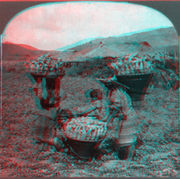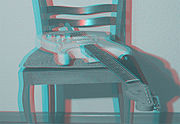- Anaglyph
-
Eine Anaglyphe bzw. ein Anaglyphenbild ist ein spezielles Stereogramm, bei dem die beiden stereoskopischen Halbbilder nicht nebeneinander dargestellt, sondern überlagert werden. Obwohl auch die übliche Polarisationsfilterprojektion eine anaglypische Darstellung ist, verwendet man die Bezeichnung Anaglyphenbild meist für Farbanaglyphen, bei denen die Halbbilder in Komplementärfarben eingefärbt werden. Die Trennung der beiden Halbbilder erfolgt mit speziellen Anaglyphenbrillen, die entsprechend gefärbte Gläser bzw. Farbfolien besitzen. Früher wurden meist die Farben Rot und Grün bzw. Rot und Blau eingesetzt. Seit den späten 1970er Jahren gibt es das von Stephen Gibson patentierte „Deep Vision“-Verfahren, das heute meist verwendet wird. Gibson verwendet die Filterfarben Rot (rechts) und Cyan (links). Cyan besteht zu gleichen Teilen aus Blau und Grün, und ermöglicht eine bessere Darstellung von Echtfarben.
Entwickelt wurde das Anaglyphenverfahren 1853 von Wilhelm Rollmann, der in J. C. Poggendorfs „Annalen der Physik (und Chemie)“ (Ausgabe 90, S. 180f, Halle, Leipzig) eine Arbeit mit dem Titel „Zwei neue stereoskopische Methoden“ veröffentlichte und darin das Verfahren vorstellte.
In der Anfangszeit verwendete man die Anaglyphenbilder insbesondere in mathematischen Lehrbüchern zur Veranschaulichung der Stereometrie und Trigonometrie.
Siehe auch
Weblinks
Wikimedia Foundation.


